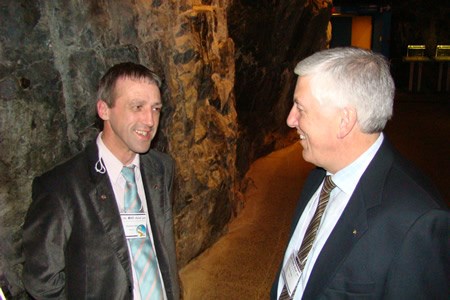What began as an idea at the heart of Laurentian University has since blossomed into a decade of internationally ground-breaking innovation, as Mining Innovation Rehabilitation and Applied Research Corporation (MIRARCO) recently celebrated its tenth anniversary.
At a gala celebration held on Oct. 15 in the Inco Cavern at Sudbury’s Science North, more than 100 attendees throughout industry, government and academia gathered to reflect on the company’s 10 years of success. Currently, MIRARCO is growing dramatically to suit its project ambitions, as it sits ready to oversee nearly $30 million worth of research.
“We aspire to be one of the biggest mining research centres in the world, and we’re certainly getting there,” says Steve Hall, president and CEO.
“Our ultimate vision is to be the partners of choice to develop the tools and the people for the mines of the future.”
The numbers speak for themselves: in 10 years, MIRARCO has led to the training of 150 students and researchers, the printing of more than 200 research publications and articles and the creation of 300 job years.
It’s estimated to have generated $15 million in community spin-offs, not to mention $5 million in cost savings, investment and revenue generation for the province’s private sector.
Recent achievements have also shown MIRARCO is certainly making great strides towards these goals. The Xuzhou Coal Mining Group, one of the top firms in China, recently purchased one of the company’s virtual reality systems to manage daily operations. What’s more, the company recently created its first commercial software, known as the Schedule Optimization Tool.
Based out of the Willet Green Miller Centre on Laurentian grounds, the workforce has also increased in recent months. In January of 2008, there were 30 employees; that number has since swollen to reach 70, more than doubling staff levels within nine months.
Hall anticipates that, within another 12 to 15 months, that number will reach to 100 employees and beyond.
“It’s been on a consistent path of growth that I never really foresaw, but it’s been consistent nonetheless,” says Peter Kaiser, former president and CEO of MIRARCO.
Kaiser was one of a handful of Laurentian University professors and researchers with expertise earned through the university’s Geomechanics Research Centre, who in 1998 agreed that the next logical step would be to create MIRARCO.
“We knew that scientists work better like soccer players and not tennis players,” says Kaiser, who now leads the Centre for Excellence in Mining Innovation (CEMI). “In soccer, you can have a lot of really good players working towards a common goal. In tennis, you’re either Roger Federer, or you’re nobody, and there aren’t many Federers.”
Ming Cai, one of the original researchers, says another advantage of forming a non-profit corporation at that point is that it avoided some of the pitfalls typically associated with informal research institutions headed up by professors.
Many informal research bodies fall apart when their leaders move on, as university staff often does, Cai says. By formalizing MIRARCO as an institution, the knowledge and experience built up would remain in place.
Though initially formed to pursue mining and environmental research and services, MIRARCO has spent much of the last decade fostering special areas of research expertise in response to the needs of industry. The organization now has three central themes of expertise, which include geohazard assessment and risk mitigation, visualization and software development, as well as environment and sustainability.
“It’s certainly evolved, but you can’t go to that type of fundamental understanding of the science and the issues without that kind of natural growth,” says Andrew Dasys, vice-president of MIRARCO.
This approach has earned the interest of not only various levels of government, but also the collaboration and investment of countless private sector partners as well.From local firms such as Vale Inco and Xstrata plc to the likes of Rio Tinto and Barrick Gold, mining firms from around the globe have supported MIRARCO’s research efforts from the outset.
It now sees broad international collaboration, with partnerships in more than 20 countries, ranging from Korea to Tanzania to Switzerland.
Kaiser says that this level of private sector support was a key component from the company’s inception, and continues to remain one of its driving strengths.




